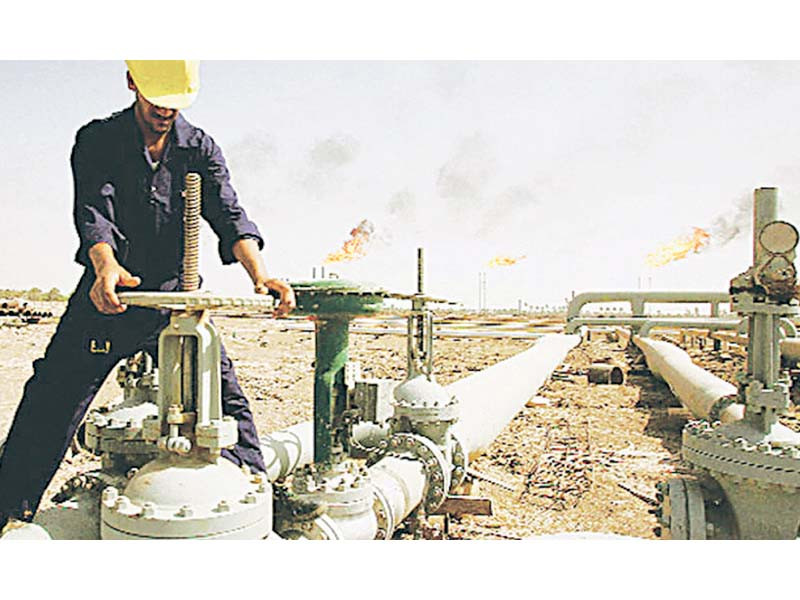.,.,.
Output to reach 50,000 bpd: OGDCL
Company adopts modern technology to reduce imports, save forex
Zafar Bhutta
September 17, 2023
OGDCL’s crude oil output stood at 32,000 bpd at the end of last financial year, but it has now crossed 34,000 barrels through renewed efforts. photo: REUTERS
State-run hydrocarbon exploration firm Oil and Gas Development Company Limited (OGDCL) is targeting to boost crude oil production to 50,000 barrels per day (bpd) to meet more consumer demand, which will help curtail imports as Pakistan is facing a dearth of US dollars.
Soon after assuming charge as OGDCL Managing Director, Ahmed Hayat Lak formed a working group on production optimisation to ramp up energy output by optimally utilising modern technologies.
This dedicated group is putting greater emphasis on individual wells and fields to increase oil and gas production with the help of technological interventions.
OGDCL’s crude oil output stood at 32,000 bpd at the end of last financial year, but it has now crossed 34,000 barrels through renewed efforts, company officials told The Express Tribune. They revealed that the company had chalked out a five-year plan to take crude oil production to 50,000 bpd.
According to the programme, some 2,000 bpd will be added to total crude oil production in financial year 2023-24, 9,379 bpd in 2024-25, 12,104 bpd in 2025-26, 16,286 bpd in 2026-27 and 19,583 bpd in 2027-28.
Pakistan is still facing scarcity of dollars, which has led to restrictions on opening Letters of Credit (LCs) for imports by all sectors. Oil refineries and oil marketing companies (OMCs) are no exception as they have also encountered hurdles in opening LCs for oil import.
In this backdrop, any increase in domestic crude oil production will be a welcome relief for the country.
According to sources, the OGDCL management has held consultations with service providers in different countries for making available state-of-the-art technology. “We have added 1,200 bpd from the Besakhi field just by installing electrical submersible pumps,” an official said.
The company has created an “indigenisation unit” to lessen reliance on imports and encourage procurement from the local industry. A dedicated team has started implementing the localisation strategy. In the first phase, imports will be slashed by 25% and local public and private-sector manufacturers will be taken on board as associated stakeholders.
Recently, an OGDCL team held meetings with renowned manufacturers and visited their facilities. The localisation plan will help to significantly reduce imports and save foreign exchange.
OGDCL has announced a remarkable achievement as part of production optimisation initiatives. It has been able to achieve impressive enhancement in production at Siab-1 well, situated in the Baratai Block in Kohat district of Khyber-Pakhtunkhwa.
Since its inception on January 13, 2022, Siab-1 well has consistently demonstrated its capability with remarkable oil and gas flow rates.
It initially recorded 125 bpd of condensate and 6.2 million standard cubic feet per day (mmscfd) of gas at a wellhead flowing pressure (WHFP) of 1,700 PSI in the Lockhart formation. Now, Siab-1 has exceeded all expectations. Through rig-less intervention within the Lockhart formation, OGDCL has embarked on a new era of hydrocarbon production. This intervention has resulted in an astounding increase in output, with the well now producing an additional 265 bpd of oil and 14.3 mmscfd of gas at a WHFP of 4,300 PSI.
The enhanced production at Siab-1 officially commenced on August 28, 2023. Since then, the well has consistently delivered handsome results, contributing a cumulative production of 20.5 mmscfd of gas and 390 bpd of oil.
Other notable accomplishments include the improved performance of Nim East-1 exploratory well.
Following the laying of a 12.5km pipeline, the well has contributed an additional production of 585 bpd of oil, 7.4 mmscfd of gas and 32 metric tons per day of liquefied petroleum gas.
The injected gas was seamlessly integrated into the Sui Southern Gas Company (SSGC)’s network, starting July 20, 2023, and had been continuously monitored till July 28, 2023. Similarly, OGDCL has installed an electrical submersible pump at well-11 of its 100% owned Pasakhi oilfield, situated in Hyderabad district of Sindh. This strategic intervention has enhanced oil production by 1,010 bpd.
At present, the well is producing 1,810 bpd of oil and is under observation to ascertain optimum flow rates. The enhanced production from Pasakhi-11 commenced on July 28, 2023. Meanwhile, the Chak 2-1 exploratory well, jointly operated by OGDCL (62.5%), Government Holdings Private Limited (22.5%) and Orient Petroleum Inc (15%), which located in Sanghar district of Sindh, has demonstrated exceptional potential with rig-less intervention.
Through additional perforations, the well’s production has gone up by 140 bpd of oil, 4.7 mmscfd of gas and 11 metric tons per day of liquefied petroleum gas.
Similarly, the Chak-V Dim South-3 well, situated in Chak-5 Dim South Block, Sanghar district, has shown good results. OGDCL has 100% working interest in the well.
Rig-less intervention with new perforations contributed to an incremental production of 130 bpd of oil, 3.8 mmscfd of gas and 8 metric tons per day of liquefied petroleum gas.
















